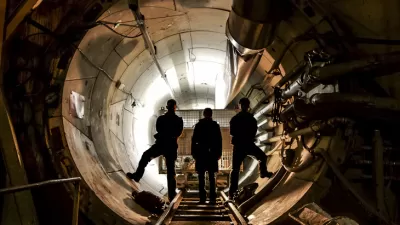Beneath Paris is an underground network of tunnels and quarries, long closed to the public. National Geographic takes a tour of this forbidden part of the city, where urban explorers keep tradition alive.
The spaces themselves are rooted in a long history of people clandestinely voyaging below ground to hide or perform acts not legal or approved above ground. Today, a culture of underground explorers is thriving.
"Entering the quarries has been illegal since 1955, so cataphiles tend to be young people fleeing the surface world and its rules. Veterans say the scene blossomed in the 1970s and '80s, when traditional Parisian rebelliousness got a fresh jolt from punk culture. Going underground was easier then, because there were many more open entrances. Some cataphiles discovered they could walk into the quarries through forgotten doorways in their school basements, then crawl onward into tunnels filled with bones-the famous catacombs. In places only they knew, the cataphiles partied, staged performances, created art, took drugs. Freedom reigned underground, even anarchy.
At first the surface world barely noticed. But by the end of the '80s the city and private property owners had shut most of the entrances, and an elite police unit began patrolling the tunnels. Yet they couldn't manage to stamp out cataphilia. The young couple I saw climbing out of a manhole that morning were cataphiles. Maybe they had been on a date; some of the men I've explored the quarries with met their future wives in the tunnels, trading phone numbers by flashlight. Cataphiles make some of the best guides to the Paris underworld. Most Parisians are only dimly aware of its extent, even though, as they ride the Métro, they may be hurtling above the bones of their ancestors."
FULL STORY: Paris Catacombs

Alabama: Trump Terminates Settlements for Black Communities Harmed By Raw Sewage
Trump deemed the landmark civil rights agreement “illegal DEI and environmental justice policy.”

Planetizen Federal Action Tracker
A weekly monitor of how Trump’s orders and actions are impacting planners and planning in America.

The 120 Year Old Tiny Home Villages That Sheltered San Francisco’s Earthquake Refugees
More than a century ago, San Francisco mobilized to house thousands of residents displaced by the 1906 earthquake. Could their strategy offer a model for the present?

Opinion: California’s SB 79 Would Improve Housing Affordability and Transit Access
A proposed bill would legalize transit-oriented development statewide.

Record Temperatures Prompt Push for Environmental Justice Bills
Nevada legislators are proposing laws that would mandate heat mitigation measures to protect residents from the impacts of extreme heat.

Downtown Pittsburgh Set to Gain 1,300 New Housing Units
Pittsburgh’s office buildings, many of which date back to the early 20th century, are prime candidates for conversion to housing.
Urban Design for Planners 1: Software Tools
This six-course series explores essential urban design concepts using open source software and equips planners with the tools they need to participate fully in the urban design process.
Planning for Universal Design
Learn the tools for implementing Universal Design in planning regulations.
Clanton & Associates, Inc.
Jessamine County Fiscal Court
Institute for Housing and Urban Development Studies (IHS)
City of Grandview
Harvard GSD Executive Education
Toledo-Lucas County Plan Commissions
Salt Lake City
NYU Wagner Graduate School of Public Service




























